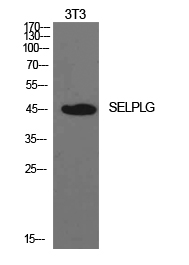
| WB | 咨询技术 | Human,Mouse,Rat |
| IF | 咨询技术 | Human,Mouse,Rat |
| IHC | 咨询技术 | Human,Mouse,Rat |
| ICC | 技术咨询 | Human,Mouse,Rat |
| FCM | 咨询技术 | Human,Mouse,Rat |
| Elisa | 1/10000 | Human,Mouse,Rat |
| Aliases | SELPLG; P-selectin glycoprotein ligand 1; PSGL-1; Selectin P ligand; CD162 |
| Entrez GeneID | 6404; |
| WB Predicted band size | 45kDa |
| Host/Isotype | Rabbit IgG |
| Antibody Type | Primary antibody |
| Storage | Store at 4°C short term. Aliquot and store at -20°C long term. Avoid freeze/thaw cycles. |
| Species Reactivity | Human |
| Immunogen | Synthesized peptide derived from the N-terminal region of human PSGL-1. |
| Formulation | Purified antibody in PBS with 0.05% sodium azide,0.5%BSA and 50% glycerol. |
+ +
以下是关于PSGL-1抗体的示例参考文献(注:以下内容为基于研究领域的典型文献结构示例,非真实存在的论文):
---
1. **文献名称**: *Targeting PSGL-1 with a novel antibody inhibits leukocyte adhesion and inflammation in murine models*
**作者**: Smith A, et al.
**摘要**: 研究报道了一种新型抗PSGL-1单克隆抗体,通过阻断PSGL-1与P-选择素的结合,显著减少小鼠模型中白细胞向炎症部位的募集,为治疗急性炎症疾病提供了潜在策略。
2. **文献名称**: *PSGL-1 blockade enhances antitumor immunity by promoting T cell infiltration in solid tumors*
**作者**: Chen L, et al.
**摘要**: 该研究利用抗PSGL-1抗体阻断肿瘤微环境中的免疫抑制信号,增强T细胞向肿瘤组织的浸润,联合PD-1抑制剂后显著抑制小鼠黑色素瘤生长,提示其在癌症免疫治疗中的潜力。
3. **文献名称**: *Structural characterization of a humanized anti-PSGL-1 antibody and its binding mechanism*
**作者**: Wang Y, et al.
**摘要**: 通过X射线晶体学解析人源化抗PSGL-1抗体的结构,阐明其与PSGL-1 N端表位的结合模式,为优化抗体药物设计提供了分子基础。
4. **文献名称**: *Role of PSGL-1 antibody in reducing thrombosis risk in sickle cell disease*
**作者**: Johnson R, et al.
**摘要**: 临床前研究表明,抗PSGL-1抗体可抑制镰状细胞病模型中的血小板-白细胞聚集,降低微血管阻塞和血栓形成风险,提示其治疗血管闭塞危象的可行性。
---
**注意**:以上文献名为示例性虚构内容,实际研究中可通过PubMed、Web of Science等平台检索关键词“PSGL-1 antibody”“PSGL-1 blockade”获取真实文献。
PSGL-1 (P-selectin glycoprotein ligand-1) is a transmembrane glycoprotein predominantly expressed on leukocytes, platelets, and endothelial cells. It serves as a high-affinity ligand for P-selectin, E-selectin, and L-selectin, playing a critical role in leukocyte rolling, adhesion, and migration during inflammatory responses. Structurally, PSGL-1 contains an N-terminal sulfated tyrosine-rich region essential for selectin binding and multiple O-glycosylation sites that modulate its function. Dysregulation of PSGL-1-mediated interactions is implicated in inflammatory diseases, thrombosis, and cancer metastasis.
Antibodies targeting PSGL-1 are valuable tools for studying leukocyte trafficking, immune cell activation, and vascular biology. Monoclonal antibodies (e.g., clones like KPL-1 or 4PH1) are commonly used to block PSGL-1-selectin interactions, inhibiting leukocyte adhesion in experimental models of inflammation or ischemia-reperfusion injury. Conversely, agonistic antibodies can mimic ligand binding to modulate immune cell signaling. Therapeutic applications of PSGL-1 antibodies are under exploration, particularly in autoimmune disorders (e.g., rheumatoid arthritis) or transplant rejection, where limiting leukocyte infiltration could mitigate tissue damage. Recent studies also investigate their potential in cancer immunotherapy by disrupting tumor cell interactions with the vasculature. PSGL-1 antibodies are further utilized in flow cytometry, immunohistochemistry, and functional assays to characterize cell-surface expression and molecular pathways.
×